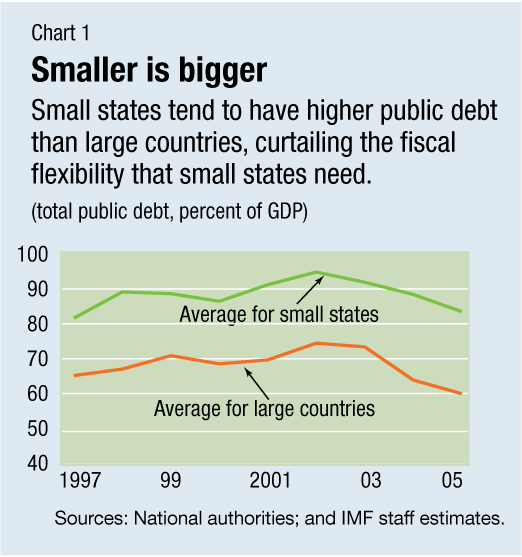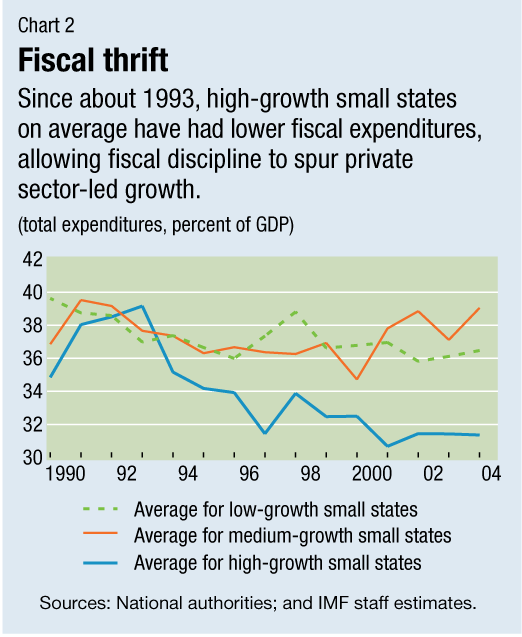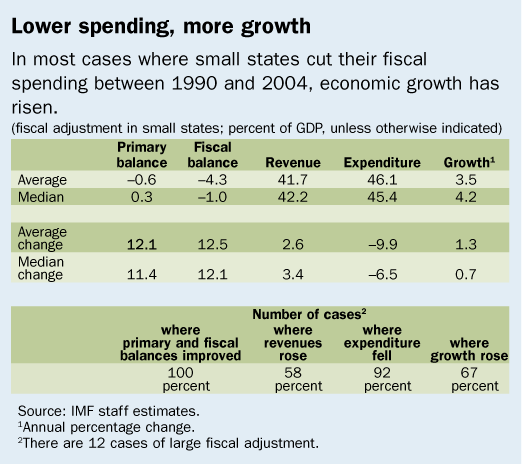
Typical street scene in Santa Ana, El Salvador. (Photo: iStock)
IMF Survey: Study Shows Many Small States Need Smaller Governments
May 1, 2008
- On average, small states have larger governments than large countries
- Small states with smaller governments tend to grow faster, be less vulnerable
- Fiscal adjustment can support small states' growth, with better governance
Fiscal policy carries greater importance in small states than in large countries, and certain fiscal characteristics of small states can affect the implementation of sound policies, according to IMF research.

Since the early 1990s, rising debt has been especially pronounced in the Caribbean countries, IMF small states study notes (photo: Newscom)
FISCAL POLICY IN SMALL STATES
A new IMF study cites two reasons for fiscal policy's greater weight and leverage in small states: first, there is greater need for countercyclical fiscal policy since small states are more prone to shocks; and second, most small states have fixed exchange rate regimes which leaves fiscal policy as the main tool for adjustment.
Small states have a population of two million or less
Since the early 1990s, in many small states a growing public debt problem has been worsened by a slowdown in growth rates, partly due to the erosion of trade preferences and to shocks. During this period, sluggish growth and fiscal pressures have emerged in some Pacific islands, for instance, while rising debt has been especially pronounced in the Caribbean countries. Low-income and African small states also tend to have very high external debt. The fiscal flexibility that these economies need is curtailed by their high debt levels.
Small states are broadly defined as developing and emerging-market countries that have a population of about two million or less. Using a new fiscal dataset for 42 small states, our analysis showed small states tend to have higher government expenditures, including spending on goods and services, wages and salaries, and capital investment.
Weak governance
Small states also tend to have weaker primary balances, higher public debt, and higher public external debt than the large countries examined (see Chart 1). Furthermore, we unveiled evidence that weak governance is significantly correlated with higher total public and external debt in small states.

Why in recent years do many small states tend to spend more, have weaker primary balances, and more public debt than large states? In reviewing the literature we found these fiscal challenges principally reflect the following characteristics of many small states:
• Remoteness and limited economies of scale help explain small states' higher cost structure, which raises government expenditures and can impact public debt. Remoteness tends to raise transport and input costs, and keeps the economy isolated.
• A lack of economic and export diversification stemming from fewer human and capital resources, and small domestic markets, can raise government expenditures because it makes small states particularly vulnerable to commodity- or weather-related shocks.
• Human resource constraints, often accentuated by a "brain drain," tend to limit capacity in both public and private sectors, which can inflate wages and government spending because skilled labor is scarcer.
• A high degree of openness, as reflected in a high ratio of external trade to GDP and in reliance on foreign capital and investment. Openness results from the fact that while small states tend to produce a narrow range of goods and services, they use a wide variety.
• Greater output volatility due, first, to their greater openness, which exposes them more to changes in world market prices and world demand; second, to their lack of economic and export diversification, which leaves them more exposed to terms of trade shocks; and, third, to a propensity to natural disasters that can impact the whole country rather than a single area.
Higher economic volatility leads to more volatility in government revenues and expenditures, which can affect public debt because shock-induced deficits may not to be fully offset by surpluses during good times.
Fiscal consolidation in small states can reduce the vulnerability caused by their weaker fiscal positions and greater susceptibility to shocks. Low public debt and a sound fiscal position give policymakers flexibility to respond counter cyclically to shocks or downturns. Weak fiscal discipline may also exacerbate economic volatility by, for example, causing bouts of fiscal expansion and contraction.
Reverse crowding out
Fiscal discipline can help reverse the crowding out of private investment and spur private-sector-led growth in many small states. This can be important because in small states the public sector tends to have a larger economic role. It is important to promote private investment for economic and export diversification in small states, which in turn can help mitigate their vulnerability to shocks.
Furthermore, there is evidence that growth is higher in small states with smaller government and lower public debt (see Chart 2). Since about 1993, high-growth small states on average have had lower revenues and grants, lower expenditures, stronger fiscal balances, and lower public debt than medium-growth and low-growth small states.

A study of episodes of large fiscal adjustment in small states confirms that, in most cases, growth actually rose (see table). An episode of large fiscal adjustment is defined as occurring when the average primary balance as a percent of GDP was at least 10 percentage points of GDP greater for a three-year period than the average primary balance for the previous three-year period.

From 1990 to 2004, there were 12 such episodes, involving nine small states. In 67 percent of these episodes, economic growth increased and the average change in growth was 1.3 percent. In fact, in only one episode was average growth negative.
Reduce spending
The most effective way to achieve fiscal adjustment is to reduce spending. The majority of episodes of large fiscal adjustment in small states involved hefty cuts in both current and capital spending; increases in revenue tended to be less frequent and less pronounced.
The small-state fiscal data also suggest that reducing current expenditure on goods and services, transfers and subsidies, and wages is associated with higher growth. High-growth small states tended to have lower spending in these three categories and higher capital spending than medium and low-growth small states.
Our empirical results suggest that improving governance may also help small states reduce public and external debt and thus support fiscal adjustment. This means that many small states should strive to improve their institutional capacity to devise and implement government policies and improve the quality of public services. Measures that enhance policy credibility, such as increasing the accountability of the government to fiscal targets, should also help raise governance standards.
Comments on this article should be sent to imfsurvey@imf.org







